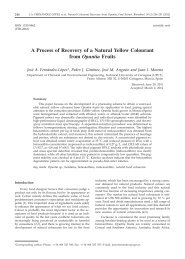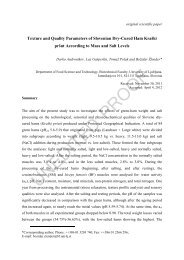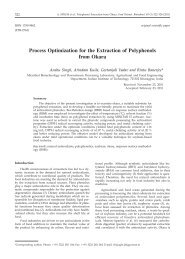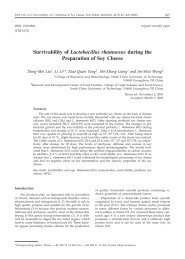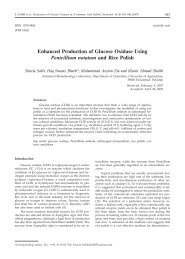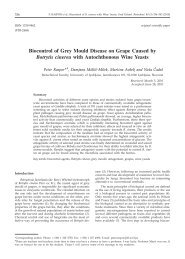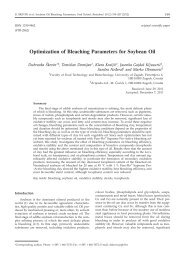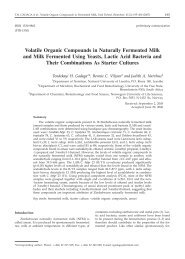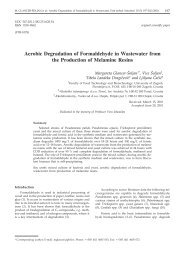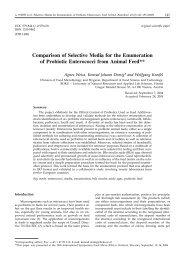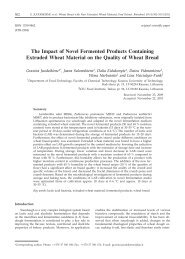120 N.S. SHALIGRAM <strong>and</strong> R.S. SINGHAL: <strong>Surfactin</strong> – A Review, <strong>Food</strong> Technol. Biotechnol. 48 (2) 119–134 (2010)Fig. 1. Structure of: a) surfactin A, B, C, D, <strong>and</strong> b) lipohexapeptidesurfactant industry exceeds US$ 9 million per year. Althoughmost of them are of petrochemical origin, biosurfactantsare gaining importance <strong>and</strong> need to competewith chemical surfactants with respect to cost, functionality<strong>and</strong> production capacity to meet the dem<strong>and</strong>. Forhigh-priced products such as cosmetics <strong>and</strong> medicine, theapplication of a biosurfactant as a low-volume, high--priced component is acceptable. However, for applicationssuch as oil recovery where high-volume <strong>and</strong> low--cost surfactants are needed, the high production cost isnot justified.Environmental compatibility is becoming increasinglyimportant in industrial processes with respect to theselection of chemicals. The advantage of biosurfactantsover synthetic surfactants has attracted attention for itsproduction on commercial scale. This review provides ageneral overview with respect to biosynthesis, fermentativeproduction, purification, analytical methods <strong>and</strong>applications of surfactin.BiosynthesisA large number of bioactive oligopeptides are producedby bacteria <strong>and</strong> fungi through a unique nonribosomalmechanism. Large modular enzymes referred toas nonribosomal peptide synthetases catalyze the biosynthesisof these low molecular mass peptides. All thesemultimodular enzymatic assemblies carry out acyl chaininitiation, elongation <strong>and</strong> chain termination, catalyzedby the protein molecules. Studies on the biosynthesis ofsurfactin began with the work of Kluge et al. (8), whoproposed a nonribosomal mechanism catalyzed by multienzymaticthiotemplates constituting the surfactin synthetase.The surfactin synthetase complex consists of fourenzymatic subunits. Three of these are enzymes SrfA(E1A, 402 kDa), SrfB (E1B, 401 kDa), SrfC (E2, 144 kDa)<strong>and</strong> the fourth is SrfD (E3, 40 kDa), which plays an importantrole in the surfactin initiation reaction (9).Each module of the peptide synthetase consists ofdifferent domains <strong>and</strong> is responsible for the incorporation<strong>and</strong> modification of one specific amino acid into thepeptide <strong>and</strong> module having co-linear sequence with thesequence of the peptide product. The surfactin synthetasecomplex is coded by the inducible operon namedsrfA (25 kb), which is also responsible for sporulation <strong>and</strong>competence development (10).The module comprises three domains: (i) fromthecognate amino acid <strong>and</strong> adenosine triphosphate (ATP),the adenylation domain catalyzes the formation of an aminoacyladenosine <strong>and</strong> releases pyrophosphate, (ii) covalentbonding of the activated amino acid to 4'-phosphopantetheinylprosthetic group present on the peptidylcarrier protein (PCP) via a thioester linkage, <strong>and</strong> (iii)condensation domain catalyzes the direct condensationof the thioesterified intermediate in a growing chain.Chain elongation chemistry in each module is different(11). In nonribosomal peptide synthetase (NRPS) assemblylines are positioned both in upstream <strong>and</strong> downstreamdirection by C-N amide bond formation. Aftercompletion of the synthesis of entire acyl chain, thechain is disconnected from the thioester by a C-terminalthioesterase (TE) domain. The chain-terminating TE domainsare 25–30 kDa protein moieties first seen in fattyacid biosynthesis. Some of the TE domains are hydrolases,e.g. vancomycin or daunomycin <strong>and</strong> some carry outregio- <strong>and</strong> stereo-specific reactions, e.g. erythromycin,while intramolecular cyclization is the most striking featureof the TE domains of SrfA-C. The acyl-O-TE intermediatedoes not undergo hydrolysis but is instead directedto intramolecular capture by a nucleophilic groupin the acyl chain. The genetically excised TE domain fromthe C-terminus of the surfactin synthetase SrfA-C subunit(SrfTE) catalyzes a stereo- <strong>and</strong> regio-specific macrolactonizationby the addition of hydroxyl oxygen of a3-(R)-3-hydroxyacyl heptapeptidyl thioester onto the Leu7carbonyl to produce the microlactone characteristic ofthe biosurfactant (12).For catalytic activity, the PCP domain of the peptidesynthetases has to be converted from apo- to holo-formsby specific phosphopantetheinyl transferases. These enzymestransfer the 4'-phosphopantetheinyl moiety of coenzymeA (CoA) to the side chain hydroxyl of invariantserine residue in all PCP domains. The production of surfactinfrom B. subtilis depends on the phosphopantetheinyltransferase Sfp, which converts the inactive apo-formsof the seven PCP domains to their active holo-forms. Interactionbetween CoA <strong>and</strong> Sfp is somewhat specific asseveral residues of Sfp that are involved in the interactionwith CoA are not conserved in other phosphopantetheinyltransferases (11).
N.S. SHALIGRAM <strong>and</strong> R.S. SINGHAL: <strong>Surfactin</strong> – A Review, <strong>Food</strong> Technol. Biotechnol. 48 (2) 119–134 (2010)1214'-Phosphopantethein (Ppant) is an essential prostheticgroup of several acyl carrier proteins involved in thesecondary metabolism. Ppant carries out two importantreactions; first the intermediates remain tethered to themultifunctional enzyme templates through energy-richlinkage, <strong>and</strong> second, the flexibility <strong>and</strong> the length ofPpant (about 20 Å) assists the transport of the intermediatesto the distinct reaction centres. Ppant moiety ispost-translationally transferred onto a serine side chain.This reaction is Mg 2+ -dependent <strong>and</strong> catalyzed by 4'--phosphopantethein transferases (PPTases) (13,14).PPTases are classified into three groups according totheir substrate <strong>and</strong> sequence homologies: (i) acyl carrierproteins (ACPs) of E. coli, found in almost all organisms.They carry out the modification of fatty acid ACP, (ii)Sfp of B. subtilis is the prototype PPTase of the secondgroup, having the length of 240 amino acids mostlyfound in the gene cluster of nonribosomal peptide synthesis.Sfp exhibits broad substrate specificity, <strong>and</strong> (iii)the third group of PPtases is found as the C-terminaldomain of FAS2 (S. cerevisiae) (15).Fermentative ProductionCommercialization of any biotechnological productdepends on its bioprocess economics. Although a largenumber of biosurfactant producers have been reportedin the literature, the product enhancement has been restrictedto a few organisms such as Bacillius, Pseudomonas<strong>and</strong> C<strong>and</strong>ida (16). Both submerged (SMF) <strong>and</strong> solid--state fermentation (SSF) have been tried for surfactinproduction.<strong>Surfactin</strong> production by submerged fermentationBiosurfactants produced by microorganisms likePseudomonas, Bacillus, C<strong>and</strong>ida <strong>and</strong> Torulopsis canbecategorizedinto five groups: glycolipids, lipopeptides, phospholipids,fatty acids <strong>and</strong> polymeric biosurfactants. <strong>Surfactin</strong>is a lipopeptide produced by Bacillus. Several approacheshave been tried to improve surfactin yield bothat flask level <strong>and</strong> fermentor level by changing environmentalparameters, optimizing medium components ortrace elements. Table 1 (3,17–22) summarizes the productivityof surfactin in various media.Addition of solid carriersA novel method was reported for the production ofsurfactin by Yeh et al. (2). Solid carriers such as activatedcarbon (AC), agar <strong>and</strong> exp<strong>and</strong>ed clay were added to thefermentation broth that used B. subtilis ATCC 21332 forthe production of surfactin. The addition of activated carbon(133 g/L) <strong>and</strong> exp<strong>and</strong>ed clay (133 g/L) produced2150 <strong>and</strong> 3300 mg/L of surfactin, respectively, while agar(20 %, by volume) produced 140 mg/L of surfactin. AC<strong>and</strong> exp<strong>and</strong>ed clay were beneficial compared to agar, asit dissolved in the medium after prolonged incubation,which is not suitable in practical surfactin fermentation.Exp<strong>and</strong>ed clay had a limitation of being very fragile,which generated small fragments after prolonged shaking.This caused difficulties in solid-liquid separation,which ultimately reduced the efficiency of isolation <strong>and</strong>purification of the surfactant. The most efficient solidcarrier was found to be AC due to its good physicalstrength. The optimized concentration of the same was25 g/L, above which it decreased the surfactin production.In order to investigate the relationship between theenhanced production of surfactin <strong>and</strong> the addition ofAC carriers, the time course profiles of cell growth <strong>and</strong>surfactin production were studied with <strong>and</strong> without ACcarriers. Higher cell growth rate with maximum finalcell concentration suggested that AC facilitated the growthof cells, <strong>and</strong> thereby the production of surfactin. Thiscould be due to AC supporting the growth of cells <strong>and</strong>consequently increasing the surfactin production.Aqueous two-phase fermentorConcentration of the product in diluted solutions, lowyields <strong>and</strong> product inhibition are the major obstacles observedin the production of biosurfactant. Drouin <strong>and</strong>Cooper (19) reported about the production of surfactinin aqueous two-phase fermentor. An aqueous two-phasesystem of polyethylene glycol (PEG-8) <strong>and</strong> dextran (D-40)was used to partition the surfactant <strong>and</strong> surfactant-producingorganism in a 2-litre cyclone fermentor. The microorganismused was B. subtilis ATCC 21332 <strong>and</strong> themedium contained 5 g/L of glucose, 0.07 M phosphatebuffer (pH=6.7) <strong>and</strong> other salts in minor quantities. Herethe partitioning of cells <strong>and</strong> surfactin was determinedby surface tension method. It was observed that the cellsTable 1. Productivity of surfactin in various mediaStrain Medium Type of fermentation g(surfactin)/(mg/L) ReferenceB. subtilis ATCC 21332 semisynthetic SMF 100 (3)B. subtilis ATCC 21332 synthetic SMF 250 (17)B. subtilis ATCC 21332 synthetic SMF 800 (in foam) (17)B. subtilis ATCC 21332 meat hydrolysate SMF 160 (18)B. subtilis ATCC 21332 synthetic SMF, aqueous two phase 350 (19)B. subtilis RB14 semisynthetic SMF 250 (20)B. subtilis RB14 okara SSF 200–250 (mg/kg wet mass) (20)B. subtilis MI113 (pC112) semisynthetic SMF 350 (20)B. subtilis MI113 (pC12) okara SSF 2000 (mg/kg wet mass) (20)B. subtilis ATCC 55033 semisynthetic SMF 3500–4300 (21)Suf-1, a mutant ofsyntheticB. subtilis ATCC 21332SMF 550 (22)




